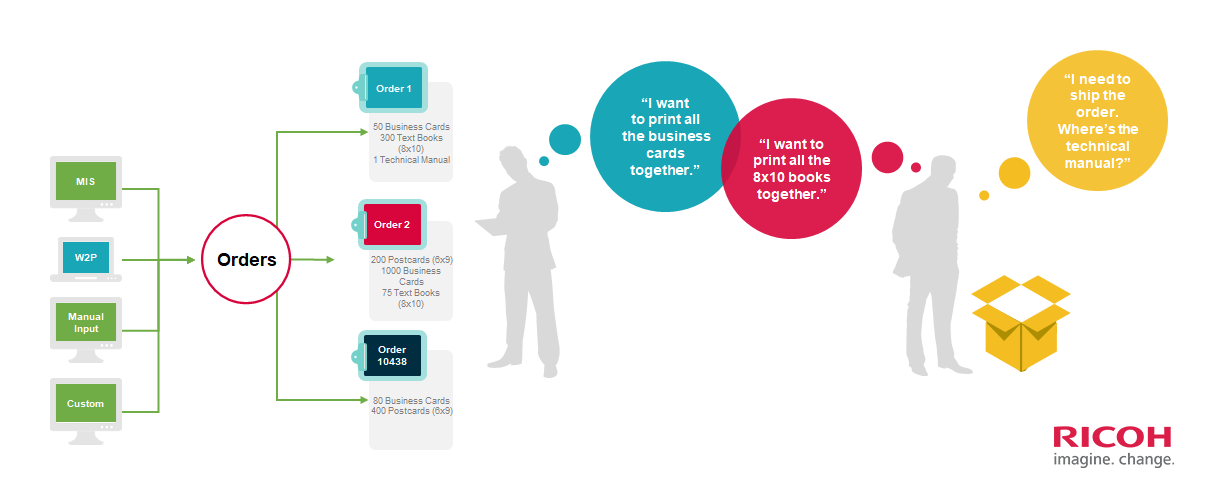In our next-day-delivery world, commercial print customers expect Amazon-like service: quick turnaround and low prices. How can commercial printers meet these rising expectations while maintaining profitable margins on increasingly smaller jobs?
The diversity of print jobs that modern print providers handle coupled with legacy workflows only compound these challenges. Printers may have hundreds of different jobs in production every day, each requiring unique equipment set-ups. Traditional first-in, first-out job prioritization requires frequent time-consuming set-up changes and manual touches.
Each manual touch adds labor costs and the potential for human error and reduces productivity, which limits your ability to take on additional jobs.
The solution? Using integrated automated batching for greater efficiency from beginning to end to address the unnecessary costs associated with shorter runs:
- Wasted substrate.
- Manual time spent grouping jobs.
- Time spent changing hardware settings between jobs.
- Device downtime.

Traditional batching has limitations
Many print shops already have multiple batching solutions in place. For example, you may have a different batching solution for each printer type or even each individual device, but lack an integrated solution.
Another limitation occurs when batching solutions group jobs that come in through a web-to-print (W2P) portal, but don’t factor in jobs onboarded through other input streams.
When systems aren’t integrated, batching and scheduling jobs from disparate onboarding streams requires human intervention. This high-touch process not only keeps print team members from more important customer-facing tasks, but it also limits printer capacity and profit margins.
Ten years ago, short-run jobs were rare due to the costs and complexity involved. Today, customer expectations have changed as technology evolved. You need integrated and automated solutions that make meeting those expectations possible.
Flexibility is essential for optimal efficiency
In addition to integrating all job submission streams, the ideal batching automation solution should be flexible. As modern print service providers print a variety of short-run jobs, each day brings a different combination of orders and customer expectations. No longer can an effective batching solution simply follow a single set of rules established when the automation software is first implemented. Production needs are constantly changing; the batching solution has to adapt to those changes.
Daily batching can include grouping jobs in multiple ways:
- By paper type and size.
- By due date.
- By finishing requirements.
- By production device.
- By shipping destination.
Today’s customers often order small runs of multiple products that need to be printed and shipped as soon as possible. As traditional scheduling tools struggle to manage a high volume of short-run jobs, each with unique specifications, print shop teams often end up bypassing these tools as they attempt to accommodate their customers’ orders. Greater batching flexibility is needed to keep your production lines running efficiently.
The solution is vendor-agnostic integrated batching software
To optimize efficiency, batching should begin as soon as jobs enter an integrated workflow. Alleviate a potential bottleneck by not leaving batching decisions to the operator when the job reaches the printer.
Automated software such as RICOH TotalFlow BatchBuilder™ can collect job information from all of input streams—storefront W2P, dedicated customer portals and orders through customer service representatives—and then analyze these jobs for optimum batching, based on daily priorities. With BatchBuilder, flexibility in setting batching criteria extends to choosing the level of automation desired. Print service providers decide how to deploy the solution in their operation. They could simply provide operators with a comprehensive dashboard view to better visualize and act on incoming work, or they can fully automate the process to free up staff to work on more high-value, customer-facing needs.
Augmenting an existing print production workflow with an integrated vendor-neutral solution like BatchBuilder enables efficient scheduling, while providing real-time visibility of every job in the pipeline. Batching jobs to maximize equipment utilization also improves hardware investment ROI and reduces operator inefficiency created by frequent changes to substrate and device set-up.
Learn more about RICOH TotalFlow BatchBuilder and how its vendor-agnostic integration can work with your existing software and hardware to most efficiently schedule high volumes of short-run jobs.
Batching is just one opportunity for improving your prepress process—download our e-book Preventing the 5 Most Common Prepress Workflow Problems to identify more ways to streamline your workflow, improve profitability and exceed customer expectations.
Ricoh’s specialists have the expertise to identify opportunities for workflow efficiency in all types of print operations. Request a workflow assessment to take an in-depth look at each stage in your production process to transform your workflow and achieve your business goals.
Meet the Author
Lisa is the Senior Product Manager for Ricoh Global. She has more than 25 years of experience in the commercial print and print technology industries and has been in her current role since 2014. She has significant experience with prepress and production management and is highly knowledgeable about holistic print ecosystems. Lisa’s experience in the commercial PSP industry embraces all aspects of the print workflow: production management, scheduling, planning, and advanced prepress integration. Lisa enjoys helping customers integrate third-party systems into their Print MIS. She has expertise in integrating products from Kodak, Agfa, Screen, and more.

Join Ricoh experts online and discover new ways to create efficiencies, reduce costs and improve profitability through our software and solutions—visit our entire webinar series to help grow your business.
Subscribe to our Newsletter
Save Time.
Save Money.
Save Headaches.
With RICOH
ProcessDirector™.

